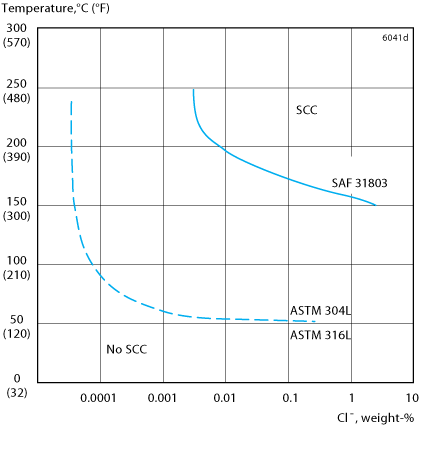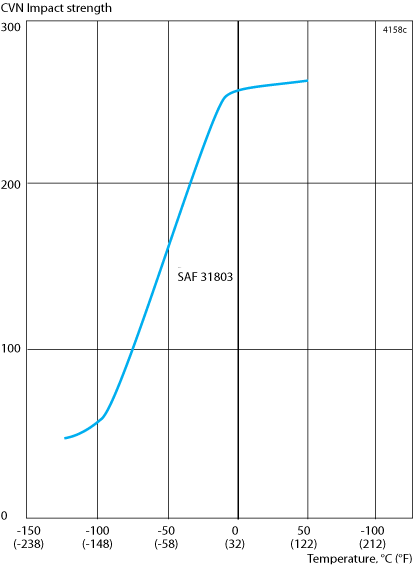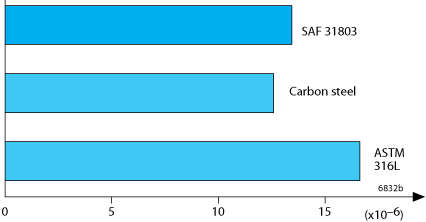SAF™ 31803 is a duplex (austenitic-ferritic) stainless steel characterized by:
- High resistance to stress corrosion cracking in chloride-bearing environments
- High resistance to stress corrosion cracking in environments containing hydrogen sulphide
- High resistance to general corrosion, pitting, and crevice corrosion
- High resistance to erosion corrosion and corrosion fatigue
- High mechanical strength - roughly twice the proof strength of austenitic stainless steel
- Physical properties that offer design advantages
- Good weldability
Standards
- UNS: S31803
Product standards
| Seamless and welded tube: | ASTM A789 |
| Seamless and welded pipe: | ASTM A790 |
Approvals
- ASME Boiler and Pressure Vessel Code, Section VIII, Div. 1 and Div. 2
- NACE MR0175/ISO 15156 (Petroleum and natural gas industries - Materials for use in H2S-containing Environments in oil and gas production - Part 1: General principles for selection of cracking-resistant materials Published:2003)
- ASME B31.3 Process Piping
Chemical composition (nominal)
| C | Si | Mn | P | S | Cr | Ni | Mo | N |
|---|---|---|---|---|---|---|---|---|
| ≤0.030 | ≤1.0 | ≤2.0 | ≤0.030 | ≤0.015 | 21.5 | 4.5 | 2.7 | 0.16 |
Applications
Due to its excellent corrosion properties, SAF™ 31803 is a highly suitable material for service in environments containing chlorides and hydrogen sulphide. SAF™ 31803 is mainly available as heat exchanger tubing and is particularly suitable for heat exchangers where chloride-bearing water or brackish water is used as a cooling medium.
The high strength of SAF™ 31803 makes the material an attractive alternative to the austenitic steels in structures subjected to heavy loads.
The good mechanical and corrosion properties make SAF™ 31803 an economical choice in many applications by reducing the life cycle cost of equipment.
Corrosion resistance
Pitting corrosion
The pitting resistance of a steel is determined primarily by its chromium and molybdenum contents, but also by its nitrogen content and its slag composition and content. The manufacturing and fabrication practices, e.g. welding, are also of vital importance for actual performance in service.
A parameter for comparing the resistance of different steels to pitting, is the PRE number (Pitting Resistance Equivalent). The PRE is defined as, in weight-%: PRE = % Cr + 3.3 x % Mo + 16 x % N
The PRE number for SAF™ 31803 is compared with other materials in the following table:
| Alloy | % Cr | % Mo | %N | PRE |
|---|---|---|---|---|
| SAF™ 2205 a) | 22 | 3.2 | 0.18 | >35 |
| SAF™ 31803 | 21.5 | 2.7 | 0.16 | >31 |
| Alloy 825 | 20 | 2.6 | - | 29 |
| ASTM 317L | 18 | 3.5 | - | 30 |
| ASTM 316L | 17 | 2.2 | - | 24 |
a) SAF™ 2205™ has a chemical composition within UNS S32205, which is optimized within the UNS S31803 range in order to provide a high PRE value.
The ranking given by the PRE number has been confirmed in laboratory tests. This ranking can generally be used to predict the performance of an alloy in chloride containing environments. Because of the high Mo and N contents, the PRE number for SAF™ 2205 is significantly higher than what would be the case with lower Mo and N contents which are still within the limits of UNS S31803.
Nevertheless, based on practical experience, SAF™ 31803 can be used at considerably higher temperatures and chloride contents than ASTM 304 and ASTM 316 without pitting. SAF™ 31803 is, therefore, far more serviceable in chloride-bearing environments than standard austenitic steels.
Stress corrosion cracking
The standard austenitic steels ASTM 304L and ASTM 316L are prone to stress corrosion cracking (SCC) in chloride-bearing solutions at temperatures above 60 °C (140 °F).
Duplex stainless steels are far less prone to this type of corrosion. Laboratory tests reveal good resistance to stress corrosion cracking of SAF™ 31803. Results from the tests are presented in Figure 3. The diagram indicates the temperature-chloride range within which SAF™ 31803 and the standard steels ASTM 304L and ASTM 316L have low susceptibility to stress corrosion cracking.

Forms of supply
Seamless tube and pipe- finishes and dimensions
Seamless tube and pipe in SAF™ 31803 is supplied in dimensions up to 260mm outside diameter. The delivery condition is solution annealed and either white pickled or bright annealed.
Mechanical properties
The following values apply to material in the solution annealed condition. Tube and pipe with wall thicknesses above 20 mm (0.787 in.) may have slightly lower values.
More detailed information can be supplied on request.
At 20 °C (68°F)
Tube and pipe with a wall thickness max. 20 mm (0.79 in.)
| Proof strength | Tensile strength | Elong. | Hardness |
|---|---|---|---|
| Rp0.2a | Rm | A2" | HRC |
| ≥450 | ≥620 | ≥25 | ≤30 |
| Proof strength | Tensile strength | Elong. | Hardness |
|---|---|---|---|
| Rp0.2a | Rm | A2" | HRC |
| ksi | ksi | % | |
| ≥65 | 90 | ≥25 | ≤30 |
1 MPa = 1 N/mm2
a) Rp0.2 corresponds to 0.2% offset yield strength.
Impact strength
SAF™ 31803 possesses good impact strength both at room temperature and at low temperatures, as is evident from Figure 1. The values apply for standard Charpy-V specimens (10 x 10 mm, 0.39 x 0.39 in.).
The impact strength of welded SAF™ 31803 is also good, despite the impact strength values in the as-welded condition being slightly lower than for weld-free material. Tests demonstrate that the impact strength of material, welded by means of gas-shielded arc welding, is good in both the weld metal and the heat-affected zone down to -50°C (-58°F). At this temperature, the impact strength is a minimum of 27 J (20 ft lb). If very high impact strength demands are made on the weld metal at low temperatures, solution annealing is recommended. This restores the impact strength of the weld metal to the same level as that of the parent metal.

At high temperatures
If SAF™ 31803 is exposed to temperatures exceeding 280°C (540°F), for prolonged periods, the microstructure changes, which results in a reduction in impact strength. This does not necessarily affect the behavior of the material at the operating temperature. For example, heat exchanger tubes can be used at higher temperatures without any problems. Please contact Alleima for more information. For pressure vessel applications, 280°C (540°F) is required as a maximum according to VdTÜV-Wb 418.
Tube and pipe with wall thickness max. 20 mm (0.79 in.)
| Temperature | Proof strength |
|---|---|
| Rp0.2 | |
| °C | MPa |
| min | |
| 50 | 415 |
| 100 | 360 |
| 150 | 335 |
| 200 | 310 |
| 250 | 295 |
| 300 | 280 |
| Temperature | Proof strength |
|---|---|
| Rp0.2 | |
| °C | ksi |
| min | |
| 120 | 60.5 |
| 200 | 53.5 |
| 300 | 48.5 |
| 400 | 45.0 |
| 500 | 42.5 |
| 600 | 40.0 |
According to ASME B31.3 the following design values are recommended for UNS S31803 (SAF™ 31803)
| Temperature, °F | °C | Stress ksi | MPa |
|---|---|---|---|
| 100 | 38 | 30.0 | 207 |
| 200 | 93 | 30.0 | 207 |
| 300 | 149 | 28.9 | 199 |
| 400 | 204 | 27.9 | 192 |
| 500 | 260 | 27.2 | 188 |
| 600 | 316 | 26.9 | 185 |
Physical properties
Density: 7.8 g/cm3, 0.28 lb/in3
| Temperature, °C | J/(kg °C) | Temperature, °F | Btu/(lb °F) |
|---|---|---|---|
| 20 | 480 | 68 | 0.11 |
| 100 | 500 | 200 | 0.12 |
| 200 | 530 | 400 | 0.13 |
| 300 | 550 | 600 | 0.13 |
| 400 | 590 | 800 | 0.14 |
Thermal conductivity
| Temperature,°C | 20 | 100 | 200 | 300 | 400 |
|---|---|---|---|---|---|
| W/(m °C) | |||||
| SAF 31803 | 14 | 16 | 17 | 19 | 20 |
| AISI 316L | 14 | 15 | 17 | 18 | 20 |
| Temperature, °F | 68 | 200 | 400 | 600 | 800 |
|---|---|---|---|---|---|
| Btu/(ft h °F) | |||||
| SAF 31803 | 8 | 9 | 10 | 11 | 12 |
| AISI 316L | 8 | 9 | 10 | 10 | 12 |
Thermal expansion, mean values in temperature ranges (X10-6)
| Temperature, °C | 30-100 | 30-200 | 30-300 | 30-400 |
|---|---|---|---|---|
| Per °C | ||||
| SAF 31803 | 13.0 | 13.5 | 14.0 | 14.5 |
| Carbon steel | 12.5 | 13.0 | 13.5 | 14.0 |
| AISI 316L | 16.5 | 17.0 | 17.5 | 18.0 |
| Temperature, °F | 86-200 | 86-400 | 86-600 | 86-800 |
|---|---|---|---|---|
| Per °F | ||||
| SAF 31803 | 7.0 | 7.5 | 8.0 | 8.0 |
| Carbon steel | 6.8 | 7.0 | 7.5 | 7.8 |
| AISI 316L | 9.0 | 9.5 | 9.8 | 10.0 |
SAF™ 31803 has a far lower coefficient of thermal expansion than austenitic stainless steels and can therefore offer certain design advantages.

| Temperature, °C | μΩm | Temperature, °F | μΩin. |
|---|---|---|---|
| 20 | 0.74 | 68 | 29.1 |
| 100 | 0.85 | 200 | 33.1 |
| 200 | 0.96 | 400 | 39.8 |
| 300 | 1.00 | 600 | 43.3 |
| 400 | 1.10 | 800 | 43.3 |
| Temperature, °C | MPa | Temperature, °F | ksi |
|---|---|---|---|
| 20 | 200 | 68 | 29.0 |
| 100 | 194 | 200 | 28.2 |
| 200 | 186 | 400 | 27.0 |
| 300 | 180 | 600 | 26.2 |
1) ( x103 )
Heat treatment
Tubes are normally delivered in the heat-treated condition. If additional heat treatment is needed due to further processing, the following is recommended.
Solution annealing
1020 - 1100 °C (1870-2010 °F), rapid cooling in air or water.
Welding
The weldability of SAF™ 31803 is good. Welding must be carried out without preheating and subsequent heat treatment is normally not necessary. Suitable methods of fusion welding are manual metal-arc welding (MMA/SMAW) and gas-shielded arc welding, with the TIG/GTAW method as first choice.
For SAF™ 31803, heat input of 0.5-2.5 kJ/mm and interpass temperature of <150°C (300°F) are recommended.
Recommended filler metals
TIG/GTAW or MIG/GMAW welding
ISO 14343 S 22 9 3 N L / AWS A5.9 ER2209 (e.g. Exaton 22.8.3.L)
MMA/SMAW welding
ISO 3581 E 22 9 3 N L R / AWS A5.4 E2209-17 (e.g. Exaton 22.9.3.LR)
ISO 3581 E 22 9 3 N L B / AWS A5.4 E2209-15 (e.g. Exaton 22.9.3.LB)
ISO 14343 S 22 9 3 N L / AWS A5.9 ER2209 (e.g. Exaton 22.8.3.L) wire or strip electrodes are recommended for overlay welding of tube sheets and high-pressure vessels in cases where corrosion resistance, equal to that of SAF™ 31803, is required.
Fabrication
Bending
The starting force needed for bending is slightly higher for SAF™ 31803 than for standard austenitic grades (ASTM 304L and 316L). SAF™ 31803 can be cold-bent to 25% deformation without requiring subsequent heat treatment. For pressure vessel applications in Germany and the Nordic countries, heat treatment may be required after cold deformation in accordance with VdTÜV-Wb 418 and NGS 1606.
Under service conditions where the risk of stress corrosion cracking starts to increase, heat treatment is recommended even after moderate cold bending, for example, where the material temperature is nearly 150°C (300°F) in an oxygen-bearing, environment with around 100 ppm Cl-.
Heat treatment is carried out in the form of solution annealing (see under Heat treatment) or resistance annealing. Hot bending is carried out at 1100-950°C (2010-1740°F) and should be followed by solution annealing.
Expanding
Compared with austenitic stainless steels, SAF™ 31803 has higher proof and tensile strength. This must be borne in mind when expanding tubes into tube-sheets. Normal expanding methods can be used, but the expansion requires a higher initial force and should be undertaken in one operation.
Machining
Being a two-phase (austenitic-ferritic) material, SAF™ 31803 will present a different tool wear profile from that of single-phase steels of types ASTM 304/304L and 316/316L. The cutting speed must, therefore, be lower than that recommended for ASTM 304/304L and 316/316L. Built-up edges and chipping are to be expected. It is recommended that a tougher insert grade is used than when machining austenitic stainless steel, e.g. ASTM 304L.
A version with improved machinability, Sanmac® 2205, is available in the forms of bar and hollow bar.
Disclaimer: Recommendations are for guidance only, and the suitability of a material for a specific application can be confirmed only when we know the actual service conditions. Continuous development may necessitate changes in technical data without notice. This datasheet is only valid for Alleima materials.